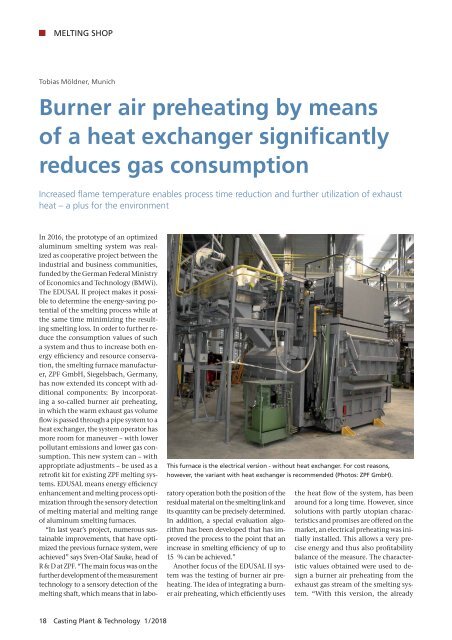CPT International 01/2018
- No tags were found...
Create successful ePaper yourself
Turn your PDF publications into a flip-book with our unique Google optimized e-Paper software.
MELTING SHOP<br />
Tobias Möldner, Munich<br />
Burner air preheating by means<br />
<br />
reduces gas consumption<br />
<br />
<br />
This furnace is the electrical version - without heat exchanger. For cost reasons,<br />
however, the variant with heat exchanger is recommended (Photos: ZPF GmbH).<br />
In 2<strong>01</strong>6, the prototype of an optimized<br />
aluminum smelting system was realized<br />
as cooperative project between the<br />
industrial and business communities,<br />
funded by the German Federal Ministry<br />
of Economics and Technology (BMWi).<br />
The EDUSAL II project makes it possible<br />
to determine the energy-saving potential<br />
of the smelting process while at<br />
the same time minimizing the resulting<br />
smelting loss. In order to further reduce<br />
the consumption values of such<br />
a system and thus to increase both energy<br />
efficiency and resource conservation,<br />
the smelting furnace manufacturer,<br />
ZPF GmbH, Siegelsbach, Germany,<br />
has now extended its concept with additional<br />
components: By incorporating<br />
a so-called burner air preheating,<br />
in which the warm exhaust gas volume<br />
flow is passed through a pipe system to a<br />
heat exchanger, the system operator has<br />
more room for maneuver – with lower<br />
pollutant emissions and lower gas consumption.<br />
This new system can – with<br />
appropriate adjustments – be used as a<br />
retrofit kit for existing ZPF melting systems.<br />
EDUSAL means energy efficiency<br />
enhancement and melting process optimization<br />
through the sensory detection<br />
of melting material and melting range<br />
of aluminum smelting furnaces.<br />
“In last year’s project, numerous sustainable<br />
improvements, that have optimized<br />
the previous furnace system, were<br />
achieved” says Sven-Olaf Sauke, head of<br />
R & D at ZPF. “The main focus was on the<br />
further development of the measurement<br />
technology to a sensory detection of the<br />
melting shaft, which means that in laboratory<br />
operation both the position of the<br />
residual material on the smelting link and<br />
its quantity can be precisely determined.<br />
In addition, a special evaluation algorithm<br />
has been developed that has improved<br />
the process to the point that an<br />
increase in smelting efficiency of up to<br />
15 % can be achieved.”<br />
Another focus of the EDUSAL II system<br />
was the testing of burner air preheating.<br />
The idea of integrating a burner<br />
air preheating, which efficiently uses<br />
the heat flow of the system, has been<br />
around for a long time. However, since<br />
solutions with partly utopian characteristics<br />
and promises are offered on the<br />
market, an electrical preheating was initially<br />
installed. This allows a very precise<br />
energy and thus also profitability<br />
balance of the measure. The characteristic<br />
values obtained were used to design<br />
a burner air preheating from the<br />
exhaust gas stream of the smelting system.<br />
“With this version, the already<br />
18 Casting Plant & Technology 1 / 2<strong>01</strong>8


















